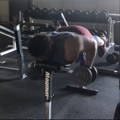Chest Supported Row
Chest Supported Row
The best exercise to build a thick upper body is? The chest supported row! This movement builds a thick upper body, a wide upper body AND it is used by some of the best Olympians on water.

The chest supported row is an old school row that has been long forgotten. Chest supported row with dumbbells, chest supported row with barbells and even kettlebells! The Chinese weightlifting team even uses chest supported row on a large bench to improve their lat strength during weightlifting movements.
The chest supported row is one of the few movements that can really overload the lats and biceps. The use of varying grips and pieces of equipment can lead to bigger lats and rear delts and even rhomboids. This helps pulling power and thus…A HUGE BACK.

When doing chest supported rows, use DB’s to get extra range of motion. Do barbell chest supported rows to improve the overload with the weight on the bar and finally, if you want a perfect mixture of both, use a cambered bar.
Some of the best canoeing Olympians in the world do chest supported row twice a week! They use the chest supported row as a means of improving explosive power. Hit 7 sets of 5 reps for strength or 4 sets of 17 for hypertrophy work!
Related Posts
Blog Topics

Yo, It's Dane
Welcome to the Garage Strength Blog, where it is my goal to provide you with the experience and knowledge I've gained in the strength and conditioning world over many years of learning from both successes and failures. I train elite-level athletes in a multitude of sports from the high school to professional levels, already producing 5 Olympics and 30+ National Champions. If you want to be the next champion I train, check out my strength programs below!
Start Training With Me

Join for free educational videos EVERY WEEK on strength coaching and athletic performance

